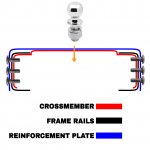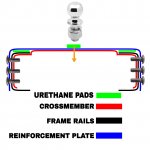sixbennetts
Adventurer
Yup. It looks like he mounted the hitch ball to the crossmember, but reinforced it first. Considering that as well, maybe a big [ shape that slides down over the crossmember AND frame sides, and bolts through that group of holes in that area. That would take most of the hitch ball weight off the crossmember and place it on top of the frame rails.
I love his idea of cutting up a cheap nylon chopping block to make a thick washer under the hitch ball! Clamp it in a vice, hit it with a small hole saw for the ball shank, then a bigger one for the outer edge! Adding a big thick washer, and the weight is spread over a larger area. Brilliant!
My wife, "Honey! Have you seen the chopping block? I'm making dinner and I swear I saw it in the....."
I love his idea of cutting up a cheap nylon chopping block to make a thick washer under the hitch ball! Clamp it in a vice, hit it with a small hole saw for the ball shank, then a bigger one for the outer edge! Adding a big thick washer, and the weight is spread over a larger area. Brilliant!
My wife, "Honey! Have you seen the chopping block? I'm making dinner and I swear I saw it in the....."


